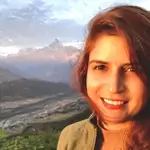OVERVIEW OF MERA PEAK CLIMBING
Mera Peak Climbing takes us to the mountainous Everest Region. Climbing Mera Peak is a challenging and rewarding experience that integrates trekking with magnificent landscapes with the adventure of getting to a Himalayan top at the highest possible elevation of 21247 feet. It offers a chance to evaluate one's mountaineering skills, soaked in wonderful sights as well as develop extraordinary memories in the heart of the Khumbu region. Mera Peak is just one of the most popular trekking peaks in Nepal, understood for its stunning breathtaking sights together with thrilling climbing up experience. Mera Peak is declared to be the highest possible trekking peak that lies in the Mahalangur area of the Everest Himalayas in the Solu-Khumbu area. It is suggested for the one who has actually done a high-altitude trekking and coped well which suggests it will certainly be a tough challenge.
Due to its geographical location in the area, spectacular views of Chamlang, Makalu, Baruntse, Lhotse, and Mount Everest can be seen from the summit.
Mera Peak is a popular climbing destination that does not follow the standard Everest Trekking Route and requires only basic mountaineering skills (perhaps some more effort at the top). The climb was graded Alpine Grade F (easy) in the past but recently upgraded to Grade PD (not very difficult) for the final 40-meter climb. Nevertheless, the peak remains a top attraction among several trekkers and mountaineers.
Mera Peak was first successfully summited by Col. Jimmy Roberts and Sherpa Sen Tenzing on May 20, 1953. Since then, the mountain summit has been one of the 33 most popular destinations for peak climbing in Nepal. Hinku and Hongu Valley add spectacular highlights to the already mesmerizing climbing activity.
EXPLORING THE ROAD TO MERA PEAK
Mera Peak is located in the Khumbu region of Nepal, within the Sagarmatha National Park. It stands at an elevation of 6,476 meters (21,247 feet). Mera Peak Climbing is considered a moderately technical trekking peak, suitable for climbers with prior high-altitude trekking experience. Embarking on an 18-day adventure with the Peak, the Mera Peak expedition begins from Kathmandu and flies to Lukla.
From there, we head east towards Dudh Koshi River and Hinku Valley. Later, we descend and head northeast to reach Mera La (5415m). Climb South to reach Mera Peak. The return journey can be backtracked or routed towards the east as per the weather and direction of the climbing guide. Trek north towards Panch Pokhari (Five Lakes), cross Amphu Lapcha Pass (5850m) and descend below (done with climbing for now!) Island Peak (6189m) towards Chuklung. Soon enough, we will find ourselves on the Everest Trekking trails, finding our way back to Lukla Airport, and flying out.
As we embark through the breathtaking high alpine landscapes, the awe-inspiring Mera Peak reveals itself in all its grandeur, commanding the skyline with majestic beauty. Nestled to the south of Everest, this lofty peak stands tall above a lush valley adorned with dense forests. What makes Mera Peak truly exceptional is its strategic location, offering climbers a splendid panorama that includes the world's highest mountains, including Everest (8,848 meters), Lhotse (8,516 meters), Cho Oyu (8,201 meters), and Makalu (8,463 meters).
DIFFICULTY LEVEL OF MERA PEAK CLIMBING
Mera Peak standing high at 6,476 meters above sea level is the highest permitted trekking peak in Nepal. Climbing Mera Peak must not be taken too lightly-- it presents a genuine difficulty.
Unlike some other trekking peaks in Nepal, Mera Peak includes straightforward climbing. A lot of the climb happens on a glacier with a modest level of steepness needing crampons together with an ice axe. The last component of the climb consists of rising a snow dome at a 50-degree angle utilizing an ascender/jumar on a fixed rope. Mera Peak is rated as Alpine Grade PD showing some technological climbing coupled with complicated glaciers. It used to be graded as Alpine Grade F (easy/straightforward) yet adjustments in the glacier and the final steep section resulted in the upgraded grading.
The major difficulty lies in the high elevation. At the summit, (6 461m) oxygen degrees are around 47% and climbers ascent without additional oxygen. Altitude-related diseases are an actual concern.
Climbing Mera Peak entails several aspects consisting of prep work, preparation, as well as weather. The good news is technical skills are not necessary for this climb. Rather, it's everything about stamina coupled with endurance. We will need to stop at various spots for acclimatization to the higher altitudes and to reduce the risk of Altitude Sickness. Further, our experienced guides, Climbing experts, and Sherpa staff will provide vital assistance in this climbing experience.
To ensure a successful climb, it is essential to prioritize certain factors and make necessary adjustments. Hydration, adjusting your diet, ensuring adequate rest, honing your snow skills, and managing snow conditions can increase your chances of a successful and enjoyable Mera Peak climb.
BEST SEASON TO TRAVEL MERA PEAK
Choosing the right season significantly impacts your Mera Peak experience. Autumn (September – November) is the ideal time for Mera Peak climbing. The weather remains pleasant and stable, with clear skies and minimal rainfall. Trails are less congested compared to other seasons.
While Spring (March to May) is yet another excellent season for Mera Peak climbing. The weather conditions are stable with clear skies. Similar to autumn, trails are less crowded.
Winter (December to February) brings chiller temperatures and snow, making the climb more demanding and challenging. There are clear skies but colder conditions. Trails are quieter during winter.
The monsoon (June to August) season is not suitable and recommended for Mera Peak climbing because of heavy rainfall, slippery trails, and poor visibility. There are increased risks of avalanches and landslides.




